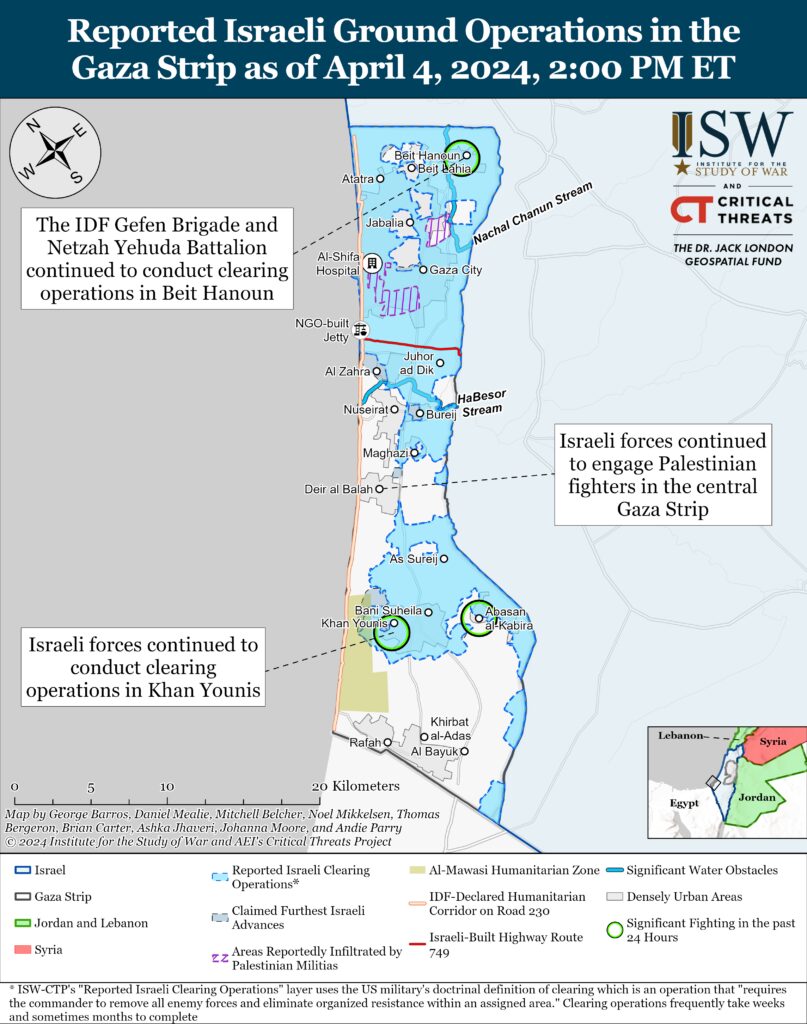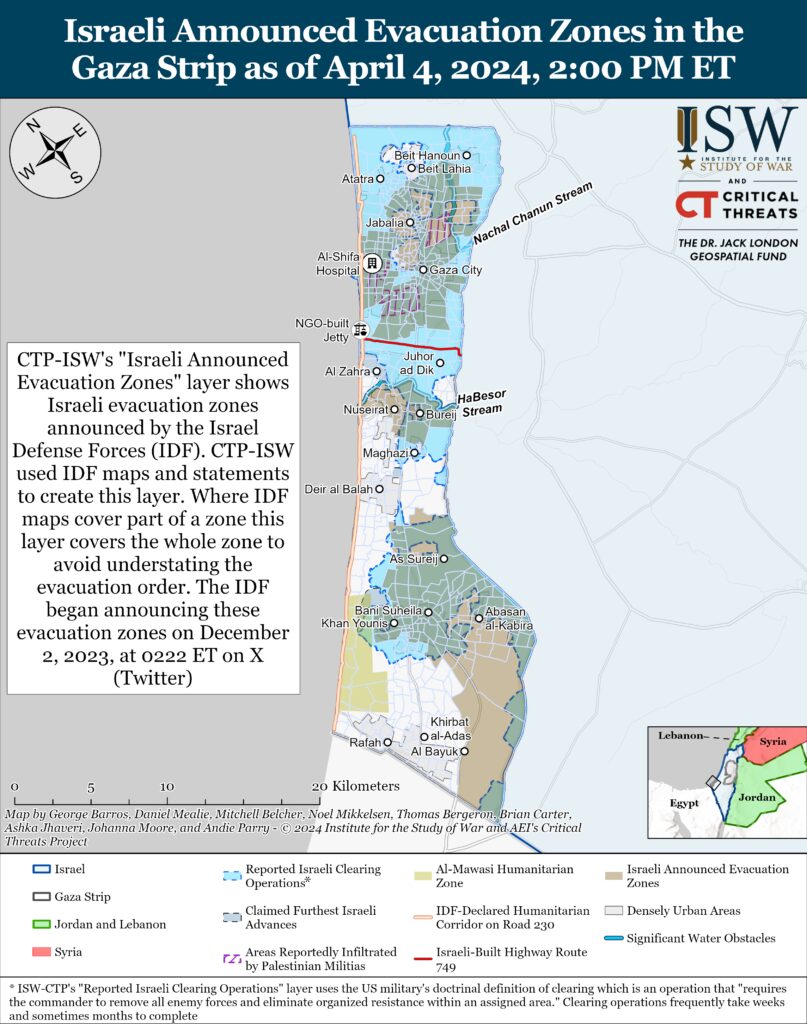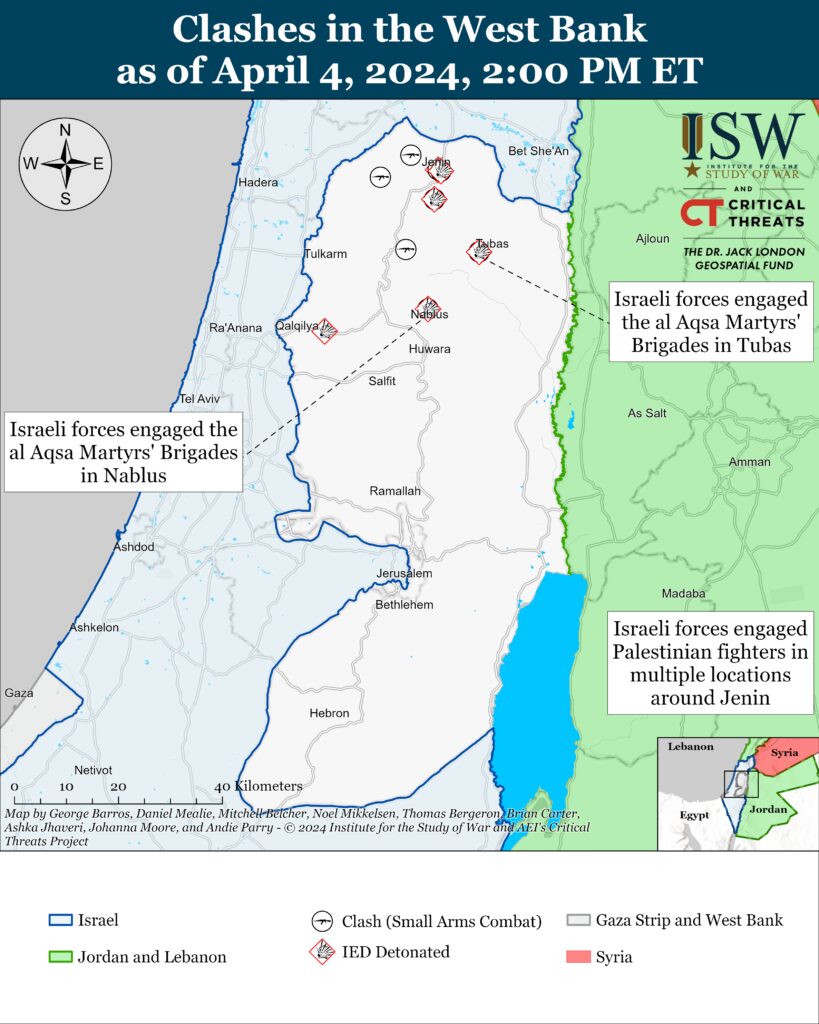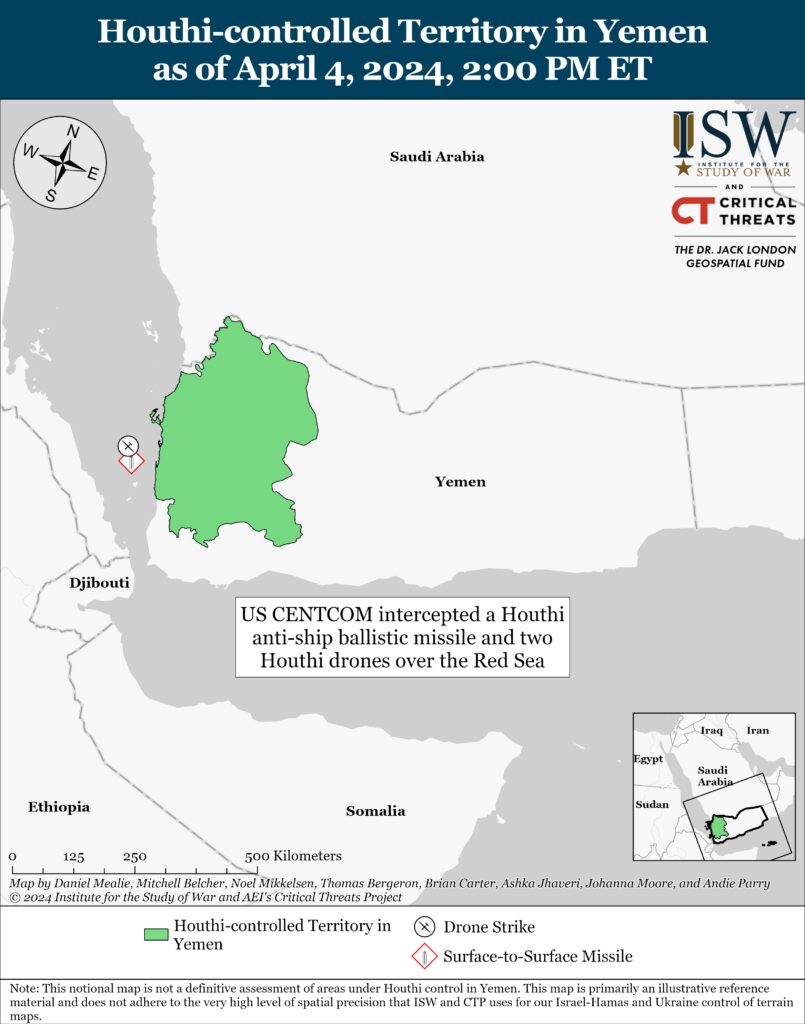Jaish al Adl, which is a Baloch, Salafi-jihadi militia, conducted unprecedentedly complex and sophisticated attacks targeting Iranian security forces in southeastern Iran on April 4.[i] Jaish al Adl conducted coordinated and simultaneous attacks targeting at least two Islamic Revolutionary Guards Corps (IRGC) headquarters, a police station, and a naval facility in Chabahar and Rask in Iran’s Sistan and Balochistan Province.[ii] Jaish al Adl claimed that it conducted attacks targeting six locations total across Sistan and Balochistan Province, although CTP-ISW cannot verify every attack.[iii] At least 11 Iranian security personnel and 18 Jaish al Adl militants died during the attacks, which began around midnight on April 4 and lasted over 13 hours.[iv]
IRGC-affiliated media reported that Jaish al Adl militants opened fire at the IRGC headquarters in Rask from the top of a nearby hospital, while other militants assaulted the headquarters with explosives.[v] Iranian military officials and state media also reported that the militants wore suicide vests, which could have been the explosives used in the attack.[vi] Iranian state media claimed that the Jaish al Adl militants failed to breach the headquarters.[vii] Jaish al Adl contrastingly claimed that it captured munitions warehouses within the IRGC headquarters and published videos showing Jaish al Adl fighters seizing unspecified military equipment at the warehouse.[viii]
Jaish al Adl separately announced that it targeted Police Station 11 in Chabahar because the former police chief raped a young Baloch girl at this station in September 2022.[ix] This incident fueled public outrage and large-scale protests in the nearby city of Zahedan, Sistan and Baluchistan Province, in late September 2022. Iranian security forces violently suppressed the protests in Zahedan in an event that became known as “Bloody Friday.”[x] Jaish al Adl vowed in early October 2022 that it would retaliate against the Iranian regime for killing protesters and “enter the field with all its power.”[xi] Jaish al Adl referencing the rape of the young Baloch girl in Chabahar is likely part of an effort to cultivate support among the local population.
Jaish al Adl separately cited Iranian cooperation with China, India, and Russia as a reason for its April 4 attacks.[xii] The group specified that it seeks to disrupt the development of the Makran coast, a coastal strip that extends between southeastern Iran and southwestern Pakistan. Other Baloch militant groups, such as the Baloch Liberation Army, have previously targeted Chinese development projects in Pakistan’s Balochistan Province.[xiii]
The Jaish al Adl attacks demonstrate the group’s growing organization and ability to use relatively advanced tactics inside Iranian territory. Jaish al Adl claimed that it coordinated 168 fighters from two different battalions and an “intelligence and security unit” to conduct the attack.[xiv] Those same two Jaish al Adl battalions previously cooperated to raid an Iranian police station in Rask in December 2023.[xv] One of the Jaish al Adl battalions involved in the April 4 attack separately organized a rare, battalion-sized training exercise in October 2022.[xvi] Most Jaish al Adl attacks involve targeted killings, IED attacks, and raids targeting Iranian security forces’ outposts.[xvii] A Jaish al Adl attack targeting a Zahedan police station in July 2023, for instance, used only four fighters equipped with suicide vests.[xviii]
The Jaish al Adl attacks risk straining the Iranian relationship with Pakistan, which Iran accuses of harboring Jaish al Adl militants.[xix] Tehran has frequently called on the Pakistani government to crack down on Jaish al Adl and to secure its border with Iran.[xx] The IRGC previously conducted drone and missile strikes targeting two Jaish al Adl “headquarters” in southwestern Pakistan in January 2024 in retaliation for an earlier Jaish al Adl attack on a police station.[xxi] The Pakistani armed forces responded to the IRGC strikes by conducting their own cross-border attacks targeting anti-Pakistan Baloch separatists in southeastern Iran.[xxii] Iranian and Pakistani officials quickly sought to deescalate tensions following the exchange of strikes, but the fundamental tension points remain.[xxiii] The Pakistani Foreign Affairs Ministry condemned the April 4 Jaish al Adl attacks, possibly to try to preemptively address the risk of rising tensions with Iran.[xxiv]
The Jaish al Adl attacks highlight the increasingly precarious state of the Iranian internal security environment. There has been a significant uptick in anti-regime militancy and terrorist activity throughout Iran in recent years. Jaish al Adl has conducted several significant attacks in this period, possibly because it has exploited the Bloody Friday incident to drive recruitment and support for itself.[xxv] The Afghanistan branch of the Islamic State, known as Islamic State Khorasan Province (ISKP), has similarly conducted several major attacks inside Iran, including two attacks on a holy shrine in Shiraz in October 2022 and August 2023 and another attack on funeral ceremony for Qassem Soleimani in January 2024.[xxvi] These security challenges compound with the fact that there have been several major, anti-regime protest waves in Iran in recent years, imposing increased strain on the Iranian internal security apparatus, as it tries to violently impose social control.
Two unspecified Iranian officials told Reuters that Iran will respond seriously to Israel killing IRGC Quds Force Brig. Gen. Mohammad Reza Zahedi in Syria but that the retaliation would also be “limited and aimed at deterrence.”[xxvii] The officials also indicated that Iran would continue trying to avoid a direct confrontation with Israel and the United States whilst continuing to support Iranian-backed attacks across the Middle East.
Palestinian Islamic Jihad (PIJ) military spokesperson “Abu Hamza” expressed support on April 4 for the anti-Israel protest movement in Jordan.[xxviii] Thousands of Jordanians have demonstrated in front of the Israeli embassy in Amman since March 24 to demand that the Jordanian government cut diplomatic ties with Israel, withdraw from the 1994 peace treaty, and cut off the trade route between the Persian Gulf and Israel that cuts through Jordanian territory.[xxix] Abu Hamza said that PIJ is following the protest movement closely and that the Jordanians’ voice ”is beginning to spread.”[xxx] The leaders of PIJ and Hamas previously praised the Jordanian protest movement on March 29.[xxxi]
The Palestinian militias’ support for the Jordanian protests comes as Iran and its so-called ”Axis of Resistance” have similarly expressed a desire to disrupt the ”land bridge” connecting Israel to the Persian Gulf.[xxxii] CTP-ISW previously assessed that Iran and its Axis of Resistance may be shifting to a more confrontational strategy vis-a-vis Jordan as part of their effort to expand their capabilities and networks in the West Bank.[xxxiii]
Key Takeaways:
- Iran: Jaish al Adl, which is a Baloch, Salafi-jihadi militia, conducted unprecedentedly complex and sophisticated attacks targeting Iranian security forces in southeastern Iran.
- Jordan: PIJ military spokesperson “Abu Hamza” expressed support on April 4 for the anti-Israel protest movement in Jordan.
- Gaza Strip: Israeli forces continued to conduct clearing operations throughout the Gaza Strip. Hamas rejected the latest Israeli ceasefire proposal.
- West Bank: The Shin Bet announced that it had detained and indicted eleven individuals, who had planned attacks against high-value targets in Israel.
- Southern Lebanon and Golan Heights: Lebanese Hezbollah conducted at least six attacks from southern Lebanon into northern Israel.
- Iraq: The Islamic Resistance in Iraq has claimed two drone attacks against Israeli civilian and military targets.
- Yemen: A senior US military official stated that the Houthis may be running low on their stockpiles of drones and anti-ship ballistic missiles due to persistent US airstrikes.

Gaza Strip
Axis of Resistance objectives:
Erode the will of the Israeli political establishment and public to sustain clearing operations in the Gaza Strip
Reestablish Hamas as the governing authority in the Gaza StripThe Israel Defense Forces (IDF) 7643rd Gefen Brigade (Gaza Division) and Netzah Yehuda Battalion (900th Kfir Brigade, 99th Reserve Division) continued to conduct clearing operations in Beit Hanoun on April 4.[xxxiv] The IDF reported that Israeli forces killed a Hamas company commander for the Beit Hanoun area during clashes with Hamas fighters. CTP-ISW assessed on March 25 that a small number of Palestinian fighters have likely infiltrated Beit Hanoun.[xxxv]
Palestinian militias have continued to conduct attacks targeting Israeli forces in Gaza City since CTP-ISW’s last data cut off on April 3. Hamas mortared Israeli forces in Tuffah in eastern Gaza City on April 3.[xxxvi] PIJ and the National Resistance Brigades conducted a combined mortar attack on April 4 targeting Israeli forces west of Gaza City in Sheikh Ijlin.[xxxvii] The al Aqsa Martyrs’ Brigades, which is the self-proclaimed military wing of Fatah, also fired a rocket-propelled grenade (RPG) at an Israeli bulldozer west of Gaza City on April 4.[xxxviii]
Israeli forces continued to engage Palestinian fighters in the central Gaza Strip on April 4. The IDF Nahal Brigade identified a group of nearby Palestinian fighters and directed an airstrike killing the fighters.[xxxix] Hamas fighters fired an RPG at an Israeli Merkava tank east of Deir al Balah.[xl]
Israeli forces continued to conduct clearing operations in Khan Younis on April 4. The 89th Commando Brigade (98th Division) killed Palestinian fighters and seized weapons in al Amal.[xli] PIJ fighters mortared Israeli forces near al Amal Hospital and al Arishya neighborhood.[xlii] The IDF 7th Brigade (36th Division) continued to conduct clearing operations in eastern Khan Younis.[xliii] PIJ targeted Israeli forces operating in a building in an unspecified area of Khan Younis with an anti-bunker bomb.[xliv] PIJ also targeted an Israeli tank in the same location with a mine.[xlv]


The IDF said on April 4 that its independent investigative body completed an inquiry into the IDF strikes that mistakenly killed seven World Central Kitchen aid workers in the central Gaza Strip.[xlvi] The General Staff Fact-Finding Assessment Mechanism, which is ”an independent military body responsible for investigating unusual incidents amid the war,“ investigated the incident “thoroughly” and briefed the IDF chief of staff on its findings. The report will be released to the public in the coming days after the key stakeholders, including the World Central Kitchen and embassy personnel, review the findings. Israeli Army Radio reported on April 3 that the IDF Nahal Brigade (162nd Division) was responsible for directing the airstrikes that killed the aid workers.[xlvii]
US President Joe Biden and Israeli Prime Minister Benjamin Netanyahu held a call to discuss the Gaza Strip on April 4.[xlviii] Biden called for an immediate ceasefire in the Gaza Strip ”to stabilize and improve the humanitarian situation and protect innocent civilians.” Biden said that the Israeli strikes on humanitarian workers and the overall humanitarian situation in the Gaza Strip are ”unacceptable.” Biden added that US policy on the Gaza Strip depends on Israel’s immediate actions to ”implement a series of specific, concrete, and measurable steps to address civilian harm, humanitarian suffering, and the safety of aid workers,” but that the United States will ”strongly support” Israel in the face of ”public Iranian threats against Israel.”
NBC reported new details of a virtual meeting between senior US and Israeli officials to discuss a possible Israeli clearing operation into Rafah. US National Security Adviser Jake Sullivan and Secretary of State Antony Blinken met virtually with Israeli National Security Adviser Tzachi Hanegbi and Israeli Minster for Strategic Affairs Ron Dermer on April 1.[xlix] Several unspecified US officials familiar with the meeting said that the plan that Israel presented to move 1.4 million civilians from Rafah to tents north of the city “did not include plans for addressing sanitation needs or an assessment of how much food or water would be required or where it would come from.”[l] The sources also reported that Israel has only considered sourcing “a fraction of the hundreds of thousands” of temporary shelters that will be needed under the plan.[li] Israeli Prime Minister Benjamin Netanyahu purchased 40,000 tents to house displaced Palestinians in the Gaza Strip in preparation for Israel’s clearing operation into Rafah, according to Israeli media on March 28.[lii]
Hamas rejected Israel’s latest ceasefire proposal on April 3. Senior Hamas official Osama Hamdan said on April 4 that Hamas had resubmitted its March 14 ceasefire proposal to Egyptian and Qatari mediators in response to Israel’s most recent proposal.[liii] Hamdan stated that Hamas was “sticking to [its] position” but also claimed that the group had shown great “flexibility” in negotiations.[liv] Hamas’ March 14 proposal includes implementing a ceasefire, calls for Israel to release Palestinian prisoners, an increase in the delivery of humanitarian aid to the Gaza Strip, a return of displaced Palestinians, and a withdrawal of Israeli forces from the Gaza Strip.[lv] Israel sent an “updated” ceasefire proposal to the mediators and Hamas on April 2.[lvi] Israel’s updated proposal reportedly allowed for the gradual return of 60,000 displaced Palestinians to the northern Gaza Strip, representing a softening of Israel’s previous position.[lvii]
Palestinian militias conducted five indirect fire attacks from the Gaza Strip into Israel since CTP-ISW’s last data cut-off on April 3.[lviii] This is the highest number of attacks launched from the Gaza Strip since February 8 and may be in anticipation of Iran’s annual, anti-Israel holiday, Quds Day, on April 5.[lix] Israeli air defenses intercepted two rockets fired by PIJ from the Gaza Strip over Netivot on April 4.[lx] Palestinian militias have not targeted Netivot since January 16.[lxi] PIJ also fired mortars and rockets at three towns in southern Israel.[lxii] The Popular Front for the Liberation of Palestine (PLFP), a secular leftist Palestinian group fighting alongside Hamas in the war, fired a rocket salvo at Kissufim.[lxiii]
The IDF Air Force struck a PIJ launch site on April 3, shortly after fighters conducted indirect fire attacks into Israel.[lxiv] The Israeli strikes destroyed several rocket launchers and militia infrastructure.[lxv]

Recorded reports of attacks; CTP-ISW cannot independently verify impact.
West Bank
Axis of Resistance objectives:
Establish the West Bank as a viable front against IsraelIsraeli forces have engaged Palestinian fighters in at least nine locations since CTP-ISW’s last data cut off on April 3.[lxvi]
The Shin Bet announced on April 4 that it had detained and indicted eleven individuals, who had planned attacks against high-value targets in Israel.[lxvii] The cell included seven Arab Israelis and four Palestinians from the West Bank, who plotted attacks against targets, including the Israeli national security minister, Ben Gurion Airport, and an unspecified government complex in Jerusalem.[lxviii] Four of the individuals in the cell were from Jenin and Tulkarm in the West Bank, where Israeli forces have repeatedly conducted operations targeting Palestinian fighters.[lxix] The individuals planned to rent land in Rahat, Israel, or in the West Bank to use for military training and weapons manufacturing.[lxx] At least one member of the cell was in contact with Hamas in the Gaza Strip, which offered funding for attacks in Israel.[lxxi] It is unclear when and where Shin Bet detained these individuals.
The indictments come amid several Palestinian attacks targeting Israeli civilians in recent months.[lxxii] Palestinian militias have repeatedly praised these attacks and called for further attacks on Israeli civilians.[lxxiii]
Israeli forces detained three individuals on April 4 who had plotted attacks in Jerusalem.[lxxiv] The individuals are from east Jerusalem and planned small arms and IED attacks targeting a sports stadium and an unspecified police station. Israeli police and the Shin Bet said that the suspects were ISIS supporters but did not specify further on the nature of the relationship.[lxxv] Israeli media reported that an ISIS affiliate had provided training to two of the suspects.[lxxvi]

This map is not an exhaustive depiction of clashes and demonstrations in the West Bank.
Southern Lebanon and Golan Heights
Axis of Resistance objectives:
Deter Israel from conducting a ground operation into Lebanon
Prepare for an expanded and protracted conflict with Israel in the near term
Expel the United States from SyriaIranian-backed militias, including Lebanese Hezbollah, have conducted at least six attacks from southern Lebanon into northern Israel since CTP-ISW’s last data cutoff on April 3.[lxxvii] [Note: A previous version of this update incorrectly stated that there were around seven attacks into northern Israel rather than six. This text and the accompanying maps have been edited to correct this error.]

Recorded reports of attacks; CTP-ISW cannot independently verify impact.
Iran and Axis of Resistance
The Islamic Resistance in Iraq—a coalition of Iranian-backed Iraqi militias—has claimed two drone attacks against Israeli civilian and military targets since CTP-ISW’s last data cut off on April 3. The Islamic Resistance in Iraq claimed a drone attack targeting the IDF Ramat David airbase in northern Israel.[lxxviii] The Islamic Resistance in Iraq also claimed a drone attack targeting Ashdod, north of the Gaza Strip.[lxxix] CTP-ISW cannot independently verify these claims.
US CENTCOM reported that it intercepted an anti-ship ballistic missile and two drones launched by the Houthis from Yemen toward the USS Gravely on April 3.[lxxx] US CENTCOM separately reported that it destroyed a Houthi mobile surface-to-air missile system on April 3.[lxxxi]
US AFCENT Commander Lt. Gen. Alexus Grynkewich said on April 3 that the Houthis may be running low on their stockpiles of drones and anti-ship ballistic missiles due to persistent US airstrikes degrading Houthi munitions stockpiles.[lxxxii] Grynkewich further stated that US airstrikes have reduced the pace of Houthi operations but did not provide further details.

The IDF has taken several defensive measures, including expanding electronic warfare GPS-spoofing, canceling IDF soldier’s weekend leave, and ”strengthening” air defenses, on April 4 in anticipation of a possible Iranian attacks on Israel in the coming days.[lxxxiii] Israeli media reported that the Israeli security establishment is worried about an Iranian missile attack on Israel.[lxxxiv] The Israeli defense minister held a “multi-front situational assessment” with top military and security officials on April 4.[lxxxv] The IDF spokesperson reassured Israeli citizens that there has been no change to the threat level in Israel, that the IDF is well prepared to defend against and attack, and that ”there is no need to buy generators, store food, and withdraw money from ATMs.”[lxxxvi]
The IRGC Navy held a naval parade in the northern Persian Gulf on April 4 as part of Iran’s annual, anti-Israel holiday, Quds Day. Iranian state media framed the parade as meant to show solidarity with the Palestinian people and demonstrate the naval capacity of the Axis of Resistance.[lxxxvii] IRGC Navy Commander Rear Adm. Ali Reza Tangsiri suggested that other members of the Axis of Resistance participated in the parade, although not where and in what capacity.[lxxxviii] Tangsiri reiterated the regime intent for this year’s Quds Day on April 5 to be more widely celebrated globally than in previous years.[lxxxix]
Supreme National Security Council (SNSC) Secretary Rear Adm. Ali Akbar Ahmadian met with the Russian National Security Council secretary and Chinese public security minister during the 19th Shanghai Cooperation Organization (SCO) meeting in Astana, Kazakhstan, on April 4.[xc] The Russian secretary and Chinese minister expressed condolences to Iran for the IRGC officials killed in an Israeli airstrike in Syria on April 1. Ahmadian thanked his Russian counterpart, Nikolai Patrushev, for Russia’s support for a UNSC meeting on the strike. Ahmadian and Patrushev discussed Russo-Iranian efforts to combat terrorism and increase bilateral economic cooperation, including the construction of the North-South transit corridor.[xci] Chinese Public Safety Minister Wang Ziaohong emphasized the need to strengthen bilateral coordination.
The United States Treasury Department’s Office of Foreign Assets Control (OFAC) designated one entity and 13 associated vessels for facilitating commodity shipments on behalf of Iran’s Armed Forces General Staff (AFGS) and the Defense and Armed Forces Logistics Ministry (MODAFL).[xcii] These designations are part of broader US efforts to counter illegal Iranian military revenue generation and ability to finance its regional proxy and partner groups.
OFAC sanctioned the following entity:
UAE-based Oceanlink Maritime DMCCOFAC sanctioned the following OceanLink Maritime DMCC-associated vessels:
Comoros-flagged Anthea
Comoros-flagged Boreas
Comoros-flagged Cape Gas
Comoros-flagged Glaucus
Comoros-flagged Oceanus Gas
Comoros-flagged Hebe
Comoros-flagged Hectate
Antigua and Barbuda-flagged Calypso Gas
Antigua and Barbuda-flagged Meraki
Belize-flagged Elsa
Belize-flagged Baxter
Panama-flagged Demeter
Cook Islands-flagged OureaOFAC updated the sanctions to account for the name change of the following vessel:
Saint Light, also known as Stellar Oracle, previously listed as Young Yong Eurasia Press & News
Eurasia Press & News




